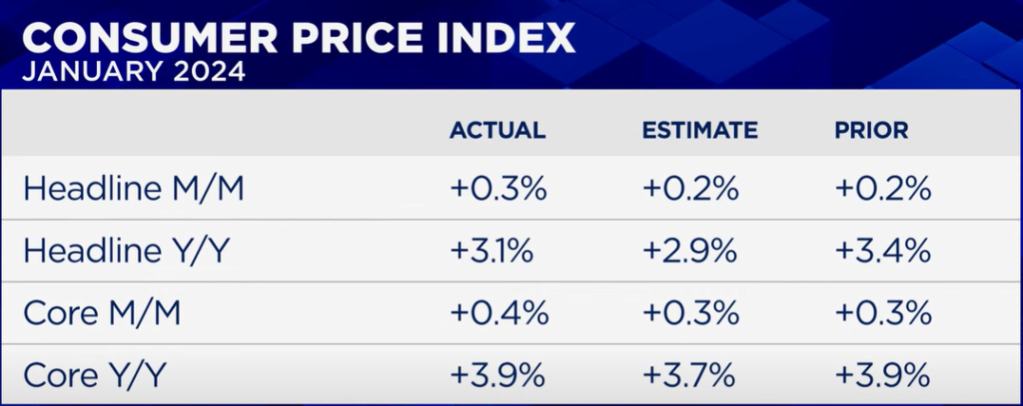From Inflation Fizzle To Sizzle
Inflation is probably still dead, but its “stickiness” still has the potential to spook financial markets. In the middle of a giddy dance on inflation’s grave, the January, 2024 CPI (consumer price index) report came in hotter than consensus expectations and sent the bond and stock market into a swirl. The following table comes from a CNBC interview with National Economic Director and former Federal Reserve vice chair Lael Brainard:
Never mind that a read hotter than consensus has little impact on the current trend. The chart below from the U.S. Bureau of Labor Statistics shows that even as core CPI (all items less food and energy) is flattening out a bit (the red line), the “sticky” shelter component of inflation is still hurtling downward (the purple line).
With the trend still favoring the death of inflation, I think of “sticky” as a reference to people’s impatience with an inflation component taking too long to converge with the overall average inflation level. The CPI report highlighted the relative stubbornness of shelter inflation:
“The shelter index increased 0.6 percent in January, and was the largest factor in the monthly increase in the index for all items less food and energy. The index for owners’ equivalent rent rose 0.6 percent over the month, while the index for rent increased 0.4 percent. The lodging away from home index increased 1.8 percent in January…The shelter index increased 6.0 percent over the last year, accounting for over two thirds of the total 12-month increase in the all items less food and energy index.”
The bubble chart below from the U.S. Bureau of Labor Statistics shows the outsized influence of services less energy services on total inflation (the large purple bubble). This major component includes shelter. Its relative importance of 60.9 dwarfs the relative importance of all other major components of inflation.
Given the angst directed at the shelter component of inflation, I looked at what the National Association of Home Builders (NAHB) had to say about this CPI report. The industry group provided a reassuring conclusion: “the NAHB forecast expects to see shelter costs decline further in the coming months. This is supported by real-time data from private data providers that indicate a cooling in rent growth.” So while the housing price picture is mixed with existing homes on the uptick and new homes on the downtick, overall rents should continue a cooling pace as expected.
Unfortunately for those traders and investors buying stocks and bonds in anticipation of rate cuts, this reminder of inflation’s stickiness pushed out expectations for the first rate cut from the Federal Reserve. Over-eager financial markets pushed out the first rate cut from May to June. This is a bitter pill to swallow for those who started buying stocks and bonds late last year in anticipation of a rate cut in March (because the Fed admitted to inflation’s death of course). The chart from the CME FedWatch Tool shows how the odds favoring a May rate cut immediately evaporated.
The U.S. Dollar
Interestingly, currency markets and the bond market have been moving counter to the rallies in the S&P 500 (SPY) and the Nasdaq (COMPX). The 2024 rally in the U.S. dollar has taken the index ABOVE the point where currency traders dumped the dollar in the wake of inflation’s death. The chart below from Tradingview.com shows a bullish breakout for the dollar last month above its 50-day moving average (DMA) (the red line) and a successful test of the trend line as support earlier this month.
(Click on image to enlarge)
The dollar’s rally complicates my bullish trades on the Canadian dollar but also provides my latest opportunity to fade USD/CAD (Invesco CurrencyShares Canadian Dollar Trust (FXC)) within the trading range. I am net long the U.S. dollar by being short EUR/USD (Invesco CurrencyShares Euro Currency Trust (FXE)).
Excluding a sharp countertrend rally at the end of January, iShares 20+ Year Treasury Bond ETF (TLT) has sold off most of 2024.
(Click on image to enlarge)
These trends further reinforce the notion and fear that perhaps that earlier rate cut expectations were indeed premature. After the market’s sell-off will stocks also concede the point or will they return to ignoring deteriorating market breadth and other signs of caution in the stock market?
The volatility index (VIX) may have already blown off enough steam…for now.
(Click on image to enlarge)
Be careful out there!
More By This Author:
Small Caps Join The Party - But Just In Time For A Rotation?
Bank Of Canada’s Macklem: The End Is In Sight But Rates Are Not Returning To Pre-Pandemic Levels
Finding The Echoes Of 1948's Inflation In Today's Inflation










